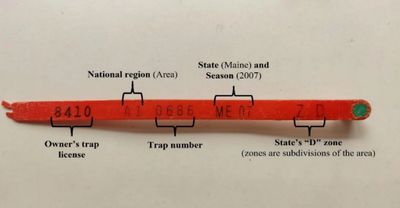Iniciaste sesión como:
filler@godaddy.com
Iniciaste sesión como:
filler@godaddy.com
Historia
La contaminación plástica ha surgido como uno de los desafíos ambientales más apremiantes a nivel mundial. Cada año, entre 4.8 y 12 millones de toneladas de desechos plásticos ingresan al océano directamente desde áreas costeras (Jambeck et al., 2015).
Estos desechos representan amenazas significativas para los ecosistemas marinos, ya que pueden dañar directamente la vida marina e introducir sustancias químicas nocivas en las cadenas alimentarias, lo que lleva a problemas como la bioacumulación y la biomagnificación (Miller et al., 2020).
Las etiquetas de identificación se utilizan en diversas actividades, incluida la pesca, donde detallan licencias, equipos de pesca y propósitos, tanto comerciales como no comerciales. En consecuencia, encontrar estas etiquetas nos permite estimar su origen o cuánto tiempo han estado en el agua (Cividanes et al., 2024).
Muchas de estas etiquetas son descubiertas incidentalmente por residentes costeros. Tales descubrimientos ofrecen una oportunidad valiosa para investigar el recorrido de estas etiquetas desde su liberación en el océano hasta su llegada a la costa.
Referencias
Cividanes, M., Aguiar-González, B., Gómez, M., Herrera, A., Martínez, I., Pham, C. K., ... & Machín, F. (2024). Lagrangian tracking of long-lasting plastic tags: From lobster fisheries in the USA and Canada to Macaronesia. Marine Pollution Bulletin, 198, 115908. https://doi.org/10.1016/j.marpolbul.2023.115908
Jambeck, J. R., Geyer, R., Wilcox, C., Siegler, T. R., Perryman, M., Andrady, A., Narayan, R., & Law, K. L. (2015). Plastic waste inputs from land into the ocean. Science, 347(6223), 768–771. https://doi.org/10.1126/SCIENCE.1260352
Miller, M. E., Hamann, M., & Kroon, F. J. (2020). Bioaccumulation and biomagnification of microplastics in marine organisms: A review and meta-analysis of current data. PLOS ONE, 15(10). https://doi.org/10.1371/JOURNAL.PONE.0240792

Este formulario está dedicado a recopilar contribuciones de ciudadanos que encuentren etiquetas de langosta en las costas de cualquier lugar del mundo. Su ayuda nos permitirá dar un significado científico a estas etiquetas de plástico liberadas en el océano. Los datos a incluir son:
Fecha de recogida de la etiqueta, lugar, código impreso en la etiqueta y color.
Si tiene una foto de la etiqueta, le agradeceríamos que lo indicase para ponernos en contacto por correo con usted.
History
Plastic pollution has emerged as one of the most pressing environmental challenges worldwide. Every year, between 4.8 and 12 million tons of plastic waste enters the ocean directly from coastal areas (Jambeck et al., 2015). This debris poses significant threats to marine ecosystems, as it can harm marine life directly and introduce harmful chemicals into food chains, leading to issues like bioaccumulation and biomagnification (Miller et al., 2020).
Identification tags are used in various activities, including fishing, where they detail licenses, fishing equipment, and purposes—both commercial and non-commercial. Consequently, finding these tags allows us to estimate their origin or how long they have been in the water (Cividanes et al., 2024)..
Many of these tags are discovered incidentally by coastal residents. Such discoveries offer a valuable opportunity to investigate the journey of these tags from their release into the ocean to their arrival on the coast.
References
Cividanes, M., Aguiar-González, B., Gómez, M., Herrera, A., Martínez, I., Pham, C. K., ... & Machín, F. (2024). Lagrangian tracking of long-lasting plastic tags: From lobster fisheries in the USA and Canada to Macaronesia. Marine Pollution Bulletin, 198, 115908. https://doi.org/10.1016/j.marpolbul.2023.115908
Jambeck, J. R., Geyer, R., Wilcox, C., Siegler, T. R., Perryman, M., Andrady, A., Narayan, R., & Law, K. L. (2015). Plastic waste inputs from land into the ocean. Science, 347(6223), 768–771. https://doi.org/10.1126/SCIENCE.1260352
Miller, M. E., Hamann, M., & Kroon, F. J. (2020). Bioaccumulation and biomagnification of microplastics in marine organisms: A review and meta-analysis of current data. PLOS ONE, 15(10). https://doi.org/10.1371/JOURNAL.PONE.0240792

This form is dedicated to gathering contributions from citizens who find lobster tags on coasts anywhere in the world. Your help will allow us to give scientific significance to these plastic tags released into the ocean. The data to include are:
Date of tag collection, location, code printed on the tag, and color.
If you have a photo of the tag, we would appreciate it if you indicated this so we can contact you via email.